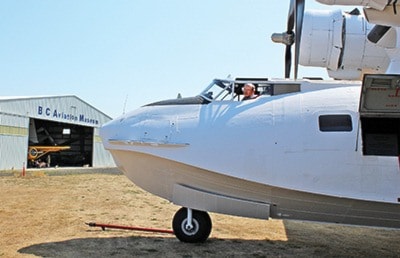By Carlie Connolly/News staff
Pat Phillips and his team along with Bob Dyck of North Saanich have been working hard to restore a PBY-5A Canso aircraft, cleaning, sanding and painting it to make it look like it is new again.
The 70-year-old aircraft has been up and away at air shows around the Island and looks the same as it did back in its prime in 1945.
“It’s fun to work on it, it’s like working in a museum in there, it hasn’t changed since 1944,” said Phillips, the president of The Catalina Preservation Society.
The Society is hoping to purchase the aircraft and keep it in Canada. Dyck bought the plane and wanted to keep it here, as it’s the last one of its kind available. And so, he stepped up to the plate, bought it privately from Buffalo Airways and brought the significant aircraft here with the intention of the society to eventually raise the money to buy it back from him and keep it in Canada as an artifact, taking it around to show the public.
“When I realized that all of our artifacts were heading out of the country, I thought I should step up to the plate and buy this one,” said Dyck.
The aircraft was originally delivered to the Saanich Peninsula in 1944 and saw service at the Pat Bay airport. It flew out of the area until the end of the Second World War and then the aircraft left, with the Royal Canadian Air Force turning it into a search and rescue aircraft, operating it until 1961.
This month, it flew for the first time in four years.
The Canso will be going to some of the air shows and is not part of the B.C. Aviation Museum (where it has been seen of late) as it’s a privately-owned aircraft operated by a private society.
This particular airplane was built in Quebec in 1943, with a bunch built in Vancouver and San Diego.
Called a patrol bomber, the aircraft was a submarine hunter, tasked with sinking a lot of submarines in the Atlantic. It also saved thousands of downed pilots during its service, designed to land in the water.
“It was a search and rescue aircraft, it was used as a torpedo bomber, all kinds of different roles,” said Phillips.
The aircraft is very slow but can stay up for a long time — 25 to 30 hours depending on what is needed to be done. It can also fly a long range.
“The second time this airplane flew in 1936, it flew 3,400 miles non stop. No airplane in the world had ever done that before,” Phillips said.
Dyck, who began flying privately in 1969, said it may be in its 71st year, but the Canso is no different than any other aircraft, having to follow a certain maintenance schedule.
Having worked for a company called the Flying Firemen for 11 years, doing fire fighting with this type of aircraft, Dyck said he has had a long association with this type of plane. He also did some flying on the coast with it in New Zealand and Africa.
“I’ve wanted to do flying for a living since I was a little kid so it was kind of like a dream come true to actually make a living at it. It’s never been a chore, it’s always been a fun day to go to work.”
The plane can be seen at air shows, open houses and museums and is still being improved and maintained at its home at the Victoria International Airport.
